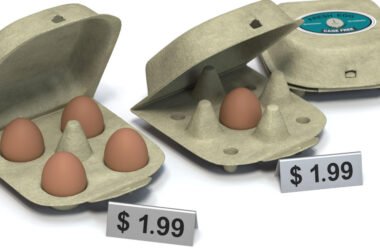The Chinese language economic system grew greater than anticipated within the first three months of the yr, new information reveals, as China constructed extra factories and exported enormous quantities of products to counter a extreme actual property disaster and sluggish spending at dwelling.
To stimulate progress, China, the world’s second-largest economic system, turned to a well-known tactic: investing closely in its manufacturing sector, together with a binge of recent factories which have helped to propel gross sales all over the world of photo voltaic panels, electrical vehicles and different merchandise.
However China’s guess on exports has apprehensive many overseas international locations and firms. They worry {that a} flood of Chinese language shipments to distant markets might undermine their manufacturing industries and result in layoffs.
On Tuesday, China’s Nationwide Bureau of Statistics stated the economic system grew 1.6 p.c within the first quarter over the earlier three months. When projected out for your entire yr, the first-quarter information signifies that China’s economic system was rising at an annual fee of about 6.6 p.c.
“The nationwide economic system made a great begin,” stated Sheng Laiyun, deputy director of the statistics bureau, whereas cautioning that “the muse for secure and sound financial progress just isn’t strong but.”
Retail gross sales elevated at a modest tempo of 4.7 p.c in contrast with the primary three months of final yr, and have been significantly weak in March.
China wants strong client spending to convey down persistently excessive youth unemployment and to assist firms and households deal with very excessive ranges of debt.
Economists on the Federal Reserve Financial institution of New York warned last month that China is experiencing a “sugar excessive” of manufacturing facility development fueled by heavy financial institution lending.
For the yr, China has set a progress goal of about 5 p.c, a purpose that many economists had seen as bold, though some have just lately upgraded their forecasts. Final yr, China’s economic system grew 5.2 p.c.
Output was 5.3 p.c increased within the first three months of this yr than throughout the identical interval final yr, the statistics bureau introduced on Tuesday, exceeding economists’ forecasts.
A breakneck tempo of manufacturing facility investments, up 9.9 p.c from a yr in the past, was central to China’s progress. Sturdy exports early this yr additionally helped.
The worth of exports rose 7 p.c in greenback phrases in January and February from a yr earlier, and 10 p.c when measured in China’s forex, the renminbi. However the precise contribution from exports to the nation’s economic system was significantly better, as falling costs obscured the total extent of China’s export features.
Guo Tingting, a vice minister of commerce, stated at a information convention final month that the bodily quantity of exports had climbed 20 p.c in January and February over final yr. Exports faltered considerably in March, nonetheless.
With road festivals and different actions, the federal government has inspired households to spend extra at the same time as many in China have stepped up their financial savings to offset a current nosedive within the worth of their residences.
Home tourism spending and field workplace ticket gross sales each rose throughout Lunar New 12 months in February, simply exceeding ranges earlier than the Covid-19 pandemic. Smartphone gross sales have additionally climbed — though not for Apple — as Chinese language patrons more and more select native manufacturers.
Broadly falling costs, a phenomenon that may turn out to be entrenched in deflation, proceed to be an issue, significantly for exports and on the wholesale degree. Chinese language firms have been vying to chop export costs and win an even bigger share of world markets, even when this implies incurring heavy losses.
Throughout top-level conferences earlier this month with Chinese language officers, Treasury Secretary Janet L. Yellen warned that flooding markets with exports would disrupt provide chains and threaten industries and jobs. Chancellor Olaf Scholz of Germany expressed comparable issues whereas on a go to to China, although he additionally cautioned in opposition to protectionism in Europe.
China is, in the meantime, experiencing a deep hunch in housing development and condo costs. The development of houses — and the manufacturing of metal, glass and different supplies for them — was the largest driver of progress in China for a few years.
However gross sales of recent residences have fallen pretty steadily because the begin of 2022. Few development initiatives are actually being began, as dozens of bancrupt or practically bancrupt builders wrestle to complete dwellings they’ve promised to patrons. Funding in actual property initiatives plunged 9.5 p.c within the first quarter from a yr earlier.
Chinese language officers blame weaknesses within the Chinese language economic system partly on excessive abroad rates of interest engineered by the Federal Reserve to fight inflation in the US. These charges have made it extra engaging for Chinese language households and firms to maneuver cash out of China, the place rates of interest are low, to overseas international locations the place charges are increased.
“The destructive impression of the excessive rate of interest surroundings on the economic system is constant,” stated Liu Haoling, the president of the China Funding Company, which is China’s sovereign wealth fund. He spoke in late March on the China Growth Discussion board, a gathering in Beijing of policymakers and executives.
China’s manufacturing juggernaut, underpinned by years of coverage directives and monetary assist from Beijing to native governments and firms, has made the nation’s items among the many world’s most cost-effective. The U.S. authorities disclosed final week that common costs for imports from China have been down 2.6 p.c in March from a yr earlier.
China has required firms to speculate extra in analysis and improvement, within the hope {that a} wave of innovation will spur financial improvement.
The nation can be requiring factories to pursue better automation. “By 2025, we could have realized a brand new kind of industrialization,” Jin Zhuanglong, the minister of business and knowledge expertise, stated on the China Growth Discussion board.
Many Chinese language households have borrowed closely to put money into residences and are responding to falling dwelling costs by slicing again their spending. That makes China extra depending on exports to promote its fast-rising industrial output.
“Chinese language firms, throughout a variety of sectors, now produce excess of home consumption can take up,” the Rhodium Group, a consulting agency, stated in a report in late March.
Individuals’s wariness about spending is one thing Li Zhenya sees day by day. He manages Izakaya Jiuben, a Japanese restaurant within the Beijing neighborhood of Wangjing, as soon as dwelling to a few of China’s greatest tech firms.
A number of years in the past, staff lined up exterior the restaurant, pouring out of close by workplaces to spend their hard-earned cash briefly breaks between lengthy shifts. Lately, lots of the restaurant’s seats are empty at lunch and dinner.
“Individuals’s need to eat just isn’t that top now,” Mr. Li at Jiuben stated. The restaurant, he stated, pulls in about $2,156 a day in income, about half its gross sales just some years in the past.
“I’m dropping cash working the restaurant,” he stated.
Jiuben is on the fourth ground of Pano Metropolis Mall, the place eating places promoting Korean, Japanese and Chinese language meals function subsequent to empty storefronts. Some locations look deserted: The lights are off however a pile of takeaway bins sits by the until, lamps nonetheless hanging or chairs and tables intact.
Centered round three curved, pebble-like buildings designed by Zaha Hadid, the neighborhood of Wangjing was as soon as a hub of exercise for the capital’s busiest staff. Eating places and retailers benefited from the presence of firms like Alibaba, JD.com and Meituan.
“The lights was once on when nighttime fell, however now no less than half of the lights are off,” Mr. Li stated.
A authorities crackdown beginning in 2020 pushed firms to cull jobs. Others left Wangjing. Covid-19 restrictions that froze the neighborhood for weeks at a time made it exhausting for small companies in Wangjing to recuperate.
“The epidemic led to a cautiousness in consumption,” stated Kou Yueyuan, the proprietor of Smoon Bakery, down the road from Pano Metropolis. “Prospects are clearly fairly price-sensitive,” Ms. Kou stated.
Ms. Kou began her enterprise greater than eight years in the past, promoting baked items like bitter melon bagels and ube mochi twists. Now she locations much less emphasis on growing new baked items with totally different flavors. As a substitute, she focuses on conserving prices low in order that the bakery can supply cheaper costs.
Li You contributed analysis.







